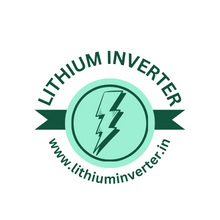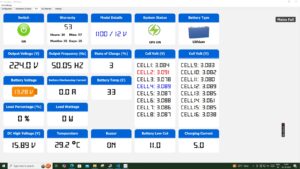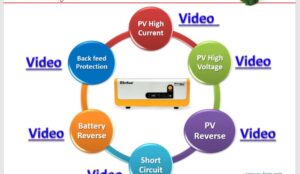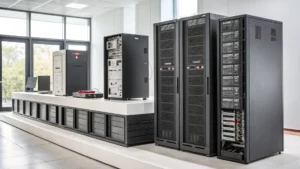Luminous launches Li-ON inverter with a lithium battery
Luminous launched its new Li-ON series integrated inverter with a lithium-ion battery in March 2022. It’s called the Luminous Li-ON 1250 and is designed for home and commercial use.
Here are some of the key features of the Luminous Li-ON
Integrated lithium-ion battery: This eliminates the need for a separate battery unit, making the system more compact and easier to install.
- Built-in: The lithium-ion battery is not a separate unit that you connect to the inverter. Instead, it’s housed within the same casing as the inverter itself [1]. This creates a more compact and streamlined design.
- Pre-assembled: Everything you need for backup power operation is already put together. There’s no separate battery to buy, install, or maintain [1].
- Optimized System: The inverter and battery are designed to work together seamlessly. This can improve efficiency, safety, and overall performance compared to using separate components
- Long battery life:
The long battery life details we can discuss depending on what device the battery is in. Here are some general points to consider, along with specific examples for inverters like the Luminous Li-ON series:
General Factors Affecting Battery Life:
- Battery Capacity: Measured in watt-hours (Wh) or milliamp-hours (mAh), it represents the total energy the battery can store. Higher capacity translates to longer runtime.
Battery capacity details provide information about the total amount of energy a battery can store and how long it can deliver power. Here’s a breakdown of the key details you might encounter:
Units of Measurement:
- Watt-hours (Wh): This is the most common unit for larger batteries, like those in inverters or electric vehicles. It represents the product of watts (power) and hours (time). So, 100Wh means the battery can deliver 100 watts of power for 1 hour, 50 watts for 2 hours, and so on.
- Milliamp-hours (mAh): This unit is typically used for smaller batteries, like those in smartphones or laptops. It represents the product of milliamps (current) and hours (time). Similar to Wh, a higher mAh rating signifies a greater capacity.
Capacity Rating:
- This is the manufacturer’s stated maximum amount of energy the battery can store, usually expressed in Wh or mAh. It represents the ideal scenario under specific conditions (e.g., moderate temperature, new battery).
Luminous launches Li-ON inverter with a lithium battery
Device Power Consumption: The amount of power (watts) a device uses determines how long the battery will last. Lower power consumption leads to longer battery life.
Device power consumption details refer to the amount of electrical energy a device uses while operating. This information is typically measured in watts (W) and tells you how much power the device draws from the power source at any given moment.
Luminous launches Li-ON inverter with a lithium battery
Here’s a breakdown of device power consumption details:
Units of Measurement:
- Watts (W): This is the standard unit for denoting device power consumption. It represents the rate at which electrical energy is used. A higher wattage value indicates the device uses more power and will consume energy faster.
How to Find Power Consumption Details:
- Device Label or Manual: Most devices have a label or information in the user manual that specifies the wattage consumption. This is often printed directly on the device itself, near the power input.
- Manufacturer Website: You can search the device model number on the manufacturer’s website to find product specifications, which usually include power consumption details.
- Energy Star Ratings: Look for the Energy Star label on some appliances. This program identifies energy-efficient products and provides estimated annual energy consumption figures.
Luminous launches Li-ON inverter with a lithium battery
Factors Affecting Device Power Consumption:
- Device Type: Different devices naturally have varying power consumption levels. For example, a gaming PC will use significantly more power than a smartphone.
- Components and Hardware: The specific components within a device (e.g., processor, screen brightness) can influence its power usage. Higher-performance components generally consume more power.
- Usage Patterns: How you use a device can significantly impact its power consumption. For instance, a phone displaying a high-resolution video will use more power than reading text on a dark background.
Understanding Power Consumption Details:
When looking at power consumption details, consider these points:
- Compare Within Device Categories: A 60W power consumption rating for a gaming laptop is normal, but high for a standard laptop.
- Impact on Battery Life: Higher power consumption translates to shorter battery life on portable devices.
- Energy Efficiency: Look for devices with lower wattage ratings or energy-saving features to reduce energy consumption and potentially save on electricity bills.
Luminous launches Li-ON inverter with a lithium battery
By understanding device power consumption details, you can make informed choices about the devices you purchase and how you use them to optimize battery life and potentially lower your energy consumption.
- Battery Chemistry: Different battery types have varying lifespans and discharge rates. Lithium-ion batteries generally outperform traditional lead-acid batteries.
- Usage Patterns: How you use the device impacts battery life. Frequent use with demanding tasks will drain the battery faster.
- Environmental Factors: Extreme temperatures (hot or cold) can shorten battery life.
Luminous launches Li-ON inverter with a lithium battery
The Luminous Li-ON 1250 has a capacity of 1100 VA and can provide a maximum output of 880 watts
It is ideal for running appliances in homes with up to 3 bedrooms or small commercial spaces.
The inverter also comes with a 5-year warranty on the inverter and battery.




